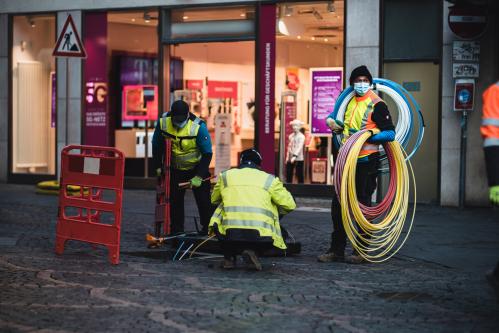The information age has transformed society in the last three decades thanks to the rapid adoption of innovative technology. While the economy in aggregate has benefited from this technological and social change, its unintended consequences have made cities more fragile. Much like cracks making a windshield more fragile, urban fragility comes about when government and individuals fracture or break social compacts. When individuals or governments ignore social compacts, it weakens society and makes cities more prone to failure when natural (or manmade) disasters inevitably strike. The examples of the municipal broadband program Wireless Philadelphia and homelessness in San Francisco both illustrate how cities can become fragile when these compacts are ignored.
One of the unintended consequences of the information age is that society is changing and stressing these compacts. In the past, city governments could afford to be reactive, but the transformative power of technology means that governments need to adopt a proactive approach of considering social problems by holistically understanding their impacts on social compacts. By viewing policies through the lens of social compacts, governments will be able to mend the rifts in the social fabric of cities and make them more resilient.
Four types of compacts
Our recent research has taken a critical look at fragility in developed cities, and focuses on how urban fragility can be addressed by understanding social compacts. Social compacts are the norms, traditions, and laws that bind society together, through both implied and explicit agreements between government and individuals (e.g., cultural norms and the U.S. Constitution). The basis of social compact is that the people and government both behave responsibly and appropriately. We categorize social compacts into four broad levels: fundamental, stability, integrity, and prosperity. The levels form a hierarchy where each build off the previous level.
- The fundamental compact is the agreement that people who live in a city will have access to the things they need to survive and function in the city, like affordable housing, access to utilities, and reliable transportation.
- The stability compact is the agreement that the city will be a safe and predictable place. Examples of a city maintaining this compact include providing police, fire safety, and public health.
- The integrity compact is the agreement that the government act with accountability and transparency. It concerns the confidence individuals have in the government to treat its citizens justly, obey the rule of law, and not abuse its power.
- The prosperity compact concerns the opportunity for city residents to enrich their lives and economic capacity. Increasingly, city governments are held responsible for attracting and retaining firms to promote the city’s economic development.
Compact failures
Homelessness in San Francisco
The fundamental compact is the foundation for all other compacts, and therefore is the most important. Unfortunately, cities sometimes prioritize fulfilling higher-level compacts like economic growth over fundamental compacts like affordable housing, causing fragility. For instance, the City of San Francisco has allowed for a relatively small portion of its population to prosper while not attending to the fundamental compact of ensuring residents have a home and can afford to live in their city. The entire San Francisco Bay Area is fragile due to scarce affordable housing and rising homelessness brought on by the success of the tech industry.
Innovation increases the productivity of companies, but has the unintended consequence of increasing income inequality. Skilled workers are well-compensated by companies, and a high concentration of skilled workers in urban areas raises the cost of living, rent, and property values, but the wages of low-skill workers in the area cannot keep up. Consequently, lower-skilled workers can no longer afford to live in the same areas that they work.
Because of this, some the most innovative economies have also become some of the most economically segregated. The San Francisco Bay Area, including Silicon Valley, is one of the most innovative areas in the U.S., but also has the highest cost of living, and one of the worst homelessness problems in the country. There are approximately 8,000 homeless people in San Francisco make up about 1 percent of the city’s total population. Additionally, the cost of living is so high that even employees at companies like Google and Facebook are living in their cars.
Municipal broadband in Philadelphia
Our new technological economy also has barriers to entry requiring cities to provide access to new essential services and utilities. In 2004, Philadelphia recognized that broadband access would eventually become a fundamental compact, and so it attempted to establish a publicly owned and operated, city-wide wireless network called Wireless Philadelphia. The goal of Wireless Philadelphia was to make broadband easily accessible and affordable to all citizens.
From its inception, Wireless Philadelphia was fraught with political and technical challenges. Internet service providers (ISPs) lobbied the Pennsylvania state legislature to restrict the project, and because several major ISPs were opposed the project, the city chose a provider that delivered a slow and flawed wireless network. While Wireless Philadelphia was designed to provide broadband service to the entire city, the poor quality of the wireless network meant that Wireless Philadelphia primarily served low-income customers.
Wireless Philadelphia only had 6,000 customers when the government shut the project down in May 2008. The city government recognized that broadband access is essential for all citizens, but failed in their compact to deliver it to the people. This failure demonstrates how society is changing in the information age faster than governments can respond. Since then, Philadelphia-based Comcast has introduce Internet Essentials, which in 2018 served 200,000 low income residents in Philadelphia alone. While it is tempting to point to Internet Essentials as an example of business triumphing where government failed, Wireless Philadelphia and Internet Essentials have different goals. Wireless Philadelphia aimed to offer quality and affordable broadband for all of its citizens; Internet Essentials opens a new market for Comcast to offer broadband at a discount price.
Laying a foundation
As city governments search for solutions to the challenges associated with technological progress of the information age, it is imperative that they remember the hierarchy of social compacts. City leaders must first ensure that solutions that encourage economic growth do not disrupt or jeopardize fundamental compacts, such as promoting innovation at the cost of standard of living. Secondly, they should understand that fractures of higher level compacts may signal failure of a deeper foundational compact. Thirdly, governments should ensure that they are fulfilling compacts for all residents, not select social groups, as happened with Philadelphia’s failed attempt at municipal broadband. By evaluating social challenges according to social compacts, cities can design holistic policies that will stabilize the city rather than increase fragility.










Commentary
How technological progress can cause urban fragility
February 7, 2019